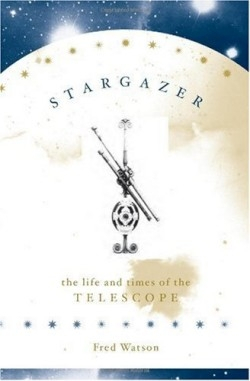Stargazer
The Life and Times of the Telescope
Historians don’t know for certain who invented the telescope. They do know when and where it emerged. In 1608, in burst upon the stage of recorded history, apparently out of Holland’s seedy world of small-time spectacle making. According to the author, who writes regularly for Sky & Space and whose articles have appeared in New Scientist, Sky & Telescope, and Astronomy Now, the necessary ingredients were all there—lenses, mirrors, an understanding of refracted light. It was inevitable that someone would discover the right combination to make a telescope.
Watson, who is also the astronomer in charge of the Anglo Australian Observatory at Coonabarabran in New South Wales, presents a lively drama of people and science that spans four centuries. The telescope itself is at the center of the story, while a constellation of brilliant and some not-so-lustrous astronomers circle around it, tinkering, improving, enlarging, and eclipsing their instrument. It is a history that will variously engage, depending on the expertise and interest level of the reader. Specialists may linger over complex diagrams and descriptions of lenses and mirrors, while non-experts may choose to skim the technical parts and focus on the eccentric personalities and episodes of “astronomers behaving badly.”
Danish-born Tycho Brahe was a giant of sixteenth-century astronomy. Unfortunately for Brahe, he died in 1601, seven years before the appearance of the telescope, yet his influence is said to have reverberated throughout the field of astronomy long after his death. The greatest name associated with the early days of the telescope was Galileo Galilei. In 1609, the Italian mathematician took the new gadget and turned it into an engine of discovery that, Watson says, “rocked the scientific and philosophical world to its foundations.” Convinced that the Earth orbited the Sun, Galileo came face to face with the awesome power of the Church and the Inquisition. Famously, he recanted.
By the twentieth century, reflecting telescopes reigned supreme, none more so that the one-hundred-inch Hooker Telescope at the Mount Wilson Observatory near Pasadena, California. It was there that young Edwin Hubble discovered that unexplained spiral nebulae were in fact extremely remote, gigantic galaxies, an observation that led astronomy to a greater understanding of the immensity of the universe and its Big Bang origins. Watson doesn’t think much of Hubble as a person, cuttingly observing that “you don’t have to be nice to be immortal.” Neither the first nor the last gifted astronomer to engage in petty power struggles, Hubble represents the dozens of fallible men who bring to life Watson’s saga of the inanimate instrument, and the scientific intrigue it provoked.
Disclosure: This article is not an endorsement, but a review. The publisher of this book provided free copies of the book to have their book reviewed by a professional reviewer. No fee was paid by the publisher for this review. Foreword Reviews only recommends books that we love. Foreword Magazine, Inc. is disclosing this in accordance with the Federal Trade Commission’s 16 CFR, Part 255.

